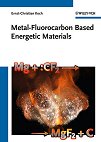Dr. Ernst-Christian Koch is the Technical Specialist Officer (TSO), Energetic Materials at the Munitions Safety Information Analysis Center (MSIAC), Brussels, Belgium, a NATO organization that provides technical consultancy services to its member nations in the area of munitions safety.
Dr. Julia Stuthe and Dr. Vera Köster, ChemViews magazine, talk to him about the fascination of fireworks, society’s need for explosives, and the future of the field which includes energetic ionic liquids.
How would you describe energetic materials?
Energetic materials (EMs) is a collective term for pure substances and compositions used as high explosives, propellants, and pyrotechnics. Once initiated energetic materials undergo self-sustaining highly exothermic reactions yielding either gaseous or condensed products and distinct luminous effects such as flame, flash, glow or spark. High explosives (HE) detonate – that is the reaction spreads in the explosive at supersonic rate – and thereby release large amounts of highly compressed gases that act as working medium to cause blast effects and accelerate metal fragments or liners. Propellants purposely also generate large amounts of hot compressed gases however they react on a slower – subsonic – scale. Finally pyrotechnics also termed pyrolants often yield large flames and produce a significant amount of condensed material and are used for a broad variety of applications such as illuminants, obscurants, igniters, delays, etc.
What is the importance of energetic materials?
The most prominent and controversial use of EM occurs is warfare. However the development of our modern societies would have been impossible without the existence of energetic materials. Explosives have been used – and are still in use – to blast roads, channels, and tunnels and thus enable international traffic and trade. Explosives are required to excavate all kinds of mineral resources and thus guarantee supply for our industry and help sustain wealth. Gas-generators powered by pyrotechnics inflate life-saving airbags in virtually every car today and have saved countless lives. Finally, the exploration of space would be impossible without the use of propulsion systems based on a wide variety of energetic materials.
You work for the Munitions Safety Information Analysis Center (MSIAC) at the NATO Headquarters in Brussels. Can you tell us a bit about your position as Technical Specialist Officer, Energetic Materials please?
MSIAC provides technical advice to its members in the field of ammunition safety. As TSO-EM my job is to address technical enquiries from our member nations that deal with energetic materials, in particular high explosives, propellants, and pyrotechnics. These enquiries are often related to synthesis, formulation, manufacture, performance, testing, sensitivity, environmental & occupational safety, and disposal of the material.
Other services include market surveys and availability studies of certain critical ingredients and technical forecasts on the development of certain fields of energetic materials such as energetic ionic liquids or gelled material.
What do you enjoy most in your job?
At MSIAC you get the opportunity to learn a great variety of topics aside from pure energetic materials from working on complex tasks together with my colleagues. In addition I enjoy having the daily challenge of communicating in a language other than my mother tongue.
What got you interested in this field?
Like many other chemists, I became fascinated by fireworks at a very early age. However, at university I had no serious intent to become involved with them on a more professional basis and was looking into organometallic chemistry as a career. Following my Ph.D., I did my military service. After my initial training with the German Air Force, I asked for a transfer to the NBC (Nuclear, Biological, Chemical) Defense Forces – which was granted – to be able to contribute to the service with my chemical knowledge. It was then that I learned about obscurants, illuminants and pyrotechnic countermeasures. Having completed my service, I applied to a manufacturer of military pyrotechnics and got hired. That’s how I became involved.
You are co-founder of the annual Workshop on Pyrotechnic Combustion Mechanisms. What is special about this meeting?
The WPC – which is an official function of the International Pyrotechnics Society – is intended to facilitate intensified exchange of scientific information on selected areas of pyrotechnics. With a regular conference schedule you don’t have the opportunity to discuss a presentation longer than 5–7 minutes. That’s why my co-chair Rutger Webb and I have decided to have a workshop setup which restricts the number of participants to about 50 and allows us to have six presentations a day as long as 45 min and discussions of similar length. By this we manage to tackle a large array of questions arising from a presentation and are able to satisfy the thirst for knowledge of our participants.
And satisfying this thirst for knowledge also inspired you to write your book Metal-Fluorocarbon Based Energetic Materials?
I definitely would say so. Initial thoughts about a book like this came quite early when I was developing a special magnesium/teflon/viton (MTV)-IR flare – which was one of my first projects when I started my career. Despite the intriguing chemistry of the highly exothermic metal/fluorocarbon reaction, only scarce information was available then in common pyrotechnic reference literature. Thus I wanted to learn more about the topic and started to collect all kinds of information related to the field and the concept of a compilation developed.
Apart from my technical objectives, I began to investigate fundamental aspects of the MTV reaction and commenced to publish about it. With an invitation to contribute to the Handbook of Combustion in late 2008 with a chapter on metal-halocarbon pyrolant combustion, I had an opportunity to write a brief overview on the subject. This activity coincided with a report released by Dr. Bernard (Bernie) Douda, Naval Surface Warfare Center, USA, on the history of the development of infrared decoy flares. Dr. Douda gave many interesting details on initial flare concepts and general development of payload chemistry. This inspired me to follow up with a closer look on the metal fluorocarbon pyrolants exclusively and get their properties and applications described in more detail.
All in all – writing a book is possibly the best exercise you can do to learn about something you want to know in more detail.
Which part of the research for your book was the most interesting for you personally?
The most interesting part for me was actually to elucidate the history of the development of the metal-fluorocarbon-based materials which actually commenced in the mid 19th century. It was kind of like detective work trying to figure out when and where the first reactions were observed and who was doing research on certain materials and why. There is a convergence between seemingly unrelated paths of research that over the years has led to the discovery/development of metal-fluorocarbon based energetic materials. As energetic materials chemists we can learn from this in such a way as to closely monitor, not only our own field, but also to look at the adjacent playing fields of chemistry, physics, and material sciences in order to make progress.
You have experience in industry and academia. Is your book more relevant for companies or universities?
A reference book like this is equally useful for someone working in the academia in the area of fluorine chemistry as well as for someone doing energetic materials research in industry. I think both need unambiguous information and I hope the book can live up to these standards.
What are the major applications of energetic materials?
The main defense applications of metal-fluorocarbon based materials (MFBEM) are of course countermeasure flares such as those based on Magnesium/Teflon®/Viton® (MTV), igniters, and reactive materials for enhanced target effects. In the civilian field, metal-fluorocarbon based materials play an increasingly important role in the high-temperature synthesis of new inorganic materials. Silicon based systems yield unique 1D-crystalline silicon carbide fibres, or 3D-dendrimeric spheres of titanium silicide. Many metal flurocarbon based systems yield fullerenes and unusual nanoscale polymorphs of carbon as reaction products. Yet the potential of shock driven reactions in MFBEM has yet to be fully explored.
Why are hazard classification testing and munitions safety such important topics?
Hazard classification of an energetic store requires knowledge of sensitivity and response (burning, deflagration, detonation) of a store towards certain stimuli, e.g., impact, friction, heat. Practicing Munitions Safety is based on this knowledge and enables authorities to regulate storage, transport, and use of stores to minimize any risk.
Where is the field heading?
Ten years ago my answer would have been “nanoscale”. However today it must be admitted that nanoscale is merely the improvement of microscale with just too many unwanted negative side-effects (oxidation, agglomeration, increased sensitivity in the case of pyrolants, etc.) that ruin any benefit you gain. Thus, to date hardly any of the nanomaterials proposed in the past have met with the expectations put on them.
A real improvement over common mechanical oxidizer/fuel systems are molecular materials such as organometallic polymers bearing electropositive metals and fluorinated chains, energetic ionic polymers and liquids, complex salts of common oxidizers with organic ligands, doped fuels and nitrogen-rich fluorocarbons, just to name a few. So this is where the future lies.
Do you use your own fireworks at New Year’s Eve?
Well as chemist I really like the smell of gunpowder and thus I like to light my own fireworks, however I rely on commercial products. I am very fond of the European-made fireworks such as large volcanoes, spinning wheels, and rockets filled with hand-made bomb shells.
Thank you very much for this interview!
 Ernst-Christian Koch graduated from the Technical University, Kaiserslautern, Germany, in 1993 and obtained a Ph.D. in inorganic chemistry in 1995. He has worked on the development and production of pyrotechnic countermeasures such as red phosphorus-based obscurants and advanced decoy flares with Piepenbrock Pyrotechnik, and Comet Pyrotechnik, both Göllheim, Germany. From 2002–2007, he worked for Diehl DGT Defence, Überlingen, Germany, as Head of the Energetic Materials Department focusing on explosive formulations for boosters and warhead charges. In 2008, he joined the Munitions Safety Information Analysis Center (MSIAC), Brussels, Belgium, as Technical Specialist Officer, Energetic Materials and is now the point of contact for the Energetic Materials Compendium (EMC), a web-based database that provides information on explosives, propellants, and pyrotechnics.
Ernst-Christian Koch graduated from the Technical University, Kaiserslautern, Germany, in 1993 and obtained a Ph.D. in inorganic chemistry in 1995. He has worked on the development and production of pyrotechnic countermeasures such as red phosphorus-based obscurants and advanced decoy flares with Piepenbrock Pyrotechnik, and Comet Pyrotechnik, both Göllheim, Germany. From 2002–2007, he worked for Diehl DGT Defence, Überlingen, Germany, as Head of the Energetic Materials Department focusing on explosive formulations for boosters and warhead charges. In 2008, he joined the Munitions Safety Information Analysis Center (MSIAC), Brussels, Belgium, as Technical Specialist Officer, Energetic Materials and is now the point of contact for the Energetic Materials Compendium (EMC), a web-based database that provides information on explosives, propellants, and pyrotechnics.
Koch is a lecturer for Energetic Materials Chemistry at Ludwig Maximilian University, Munich, Germany, and the Technical University, Kaiserslautern, Germany. He is also co-founder of the annual Workshop on Pyrotechnic Combustion Mechanisms and is a member of the Editorial Advisory Board for the Propellants Explosives Pyrotechnics journal. Koch has been on the board of directors of the International Pyrotechnics Society since 2008 and has been elected President just recently for the term 2012–2014.
Selected Publications
- Combustion of Ytterbium Metal,
E.-C. Koch, V. Weiser, E. Roth, S. Knapp, S. Kelzenberg,
Propellants, Explos. Pyrotech. 2012, 37, 9–11.
DOI: 10.1002/prep.201100141 - Metal-Fluorocarbon Pyrolants. XIV: High Density-High Performance Decoy Flare Compositions Based on Ytterbium/Polytetrafluoroethylene/Viton®,
E.-C. Koch, A. Hahma,
Z. Anorg. Allg. Chem. 2012.
DOI: 10.1002/zaac.201200036 
Metal-Fluorocarbon Based Energetic Materials
,
Ernst-Christian Koch,
Wiley-VCH, Weinheim, Germany, 2012.
ISBN: 978-3-527-32920-5
Online ISBN: 978-3-527-64418-6



